Economics 1: Oil and Gas Management Report Analysis
VerifiedAdded on 2022/08/20
|18
|4734
|13
Report
AI Summary
This report provides a comprehensive analysis of oil and gas management, addressing key aspects such as commercial relationships between oil companies and Tier 1 contractors. It examines different contractual models, including conventional list prices with bonuses, gainsharing based on operating costs, and equity stakes, outlining their advantages and disadvantages. The report also delves into petroleum economics and taxation regimes, comparing licensing models like Concession, Production Sharing Contracts (PSC), and Joint Ventures (JV), and assessing their suitability for a newly developing oil and gas industry. Furthermore, the report evaluates the impact of production efficiency variations on investment Net Present Value (NPV) through sensitivity analysis. Finally, it identifies and discusses various risks involved in oil field development, including technical, political, economic, and commercial risks, across different phases of exploration, development, and production.
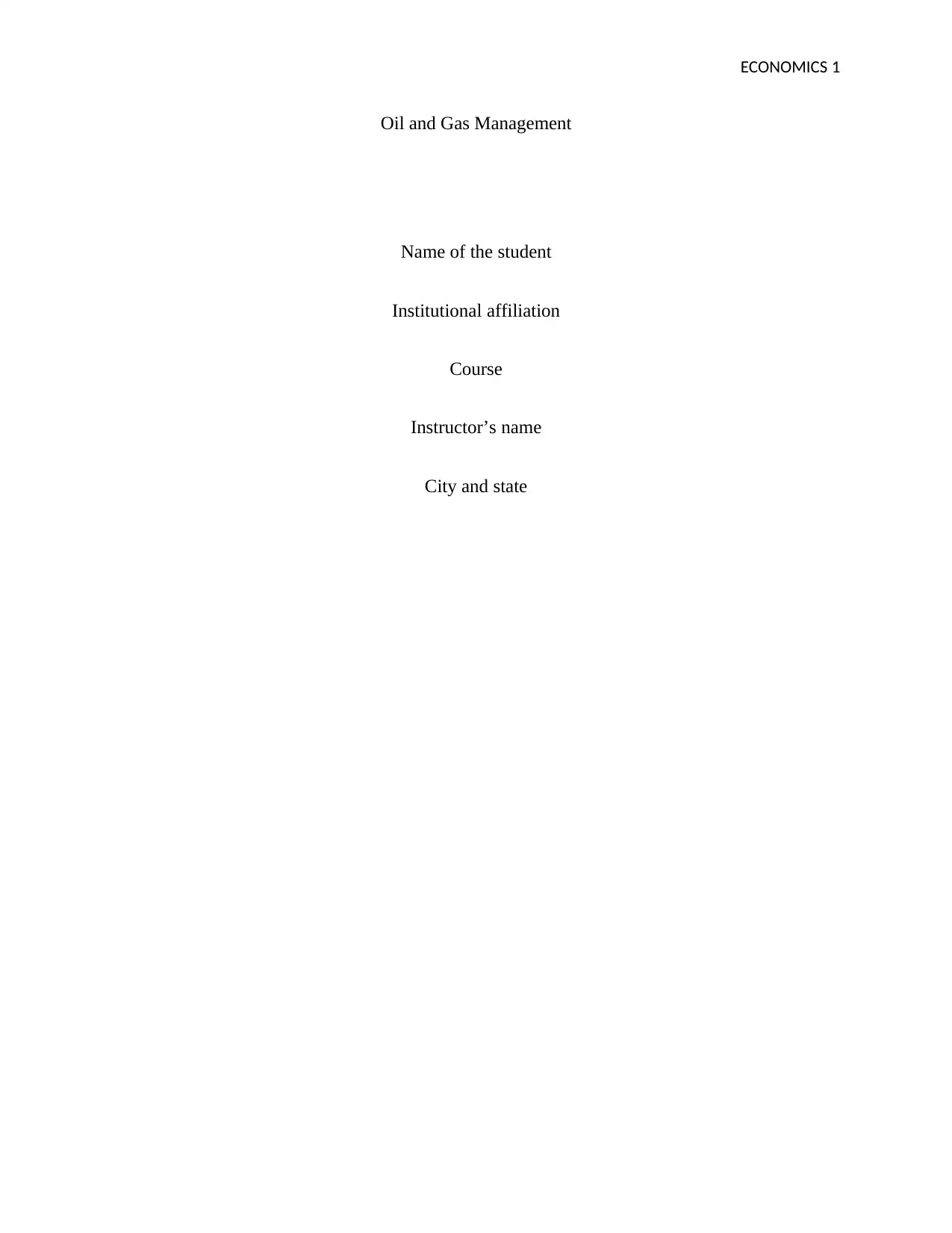
ECONOMICS 1
Oil and Gas Management
Name of the student
Institutional affiliation
Course
Instructor’s name
City and state
Oil and Gas Management
Name of the student
Institutional affiliation
Course
Instructor’s name
City and state
Paraphrase This Document
Need a fresh take? Get an instant paraphrase of this document with our AI Paraphraser
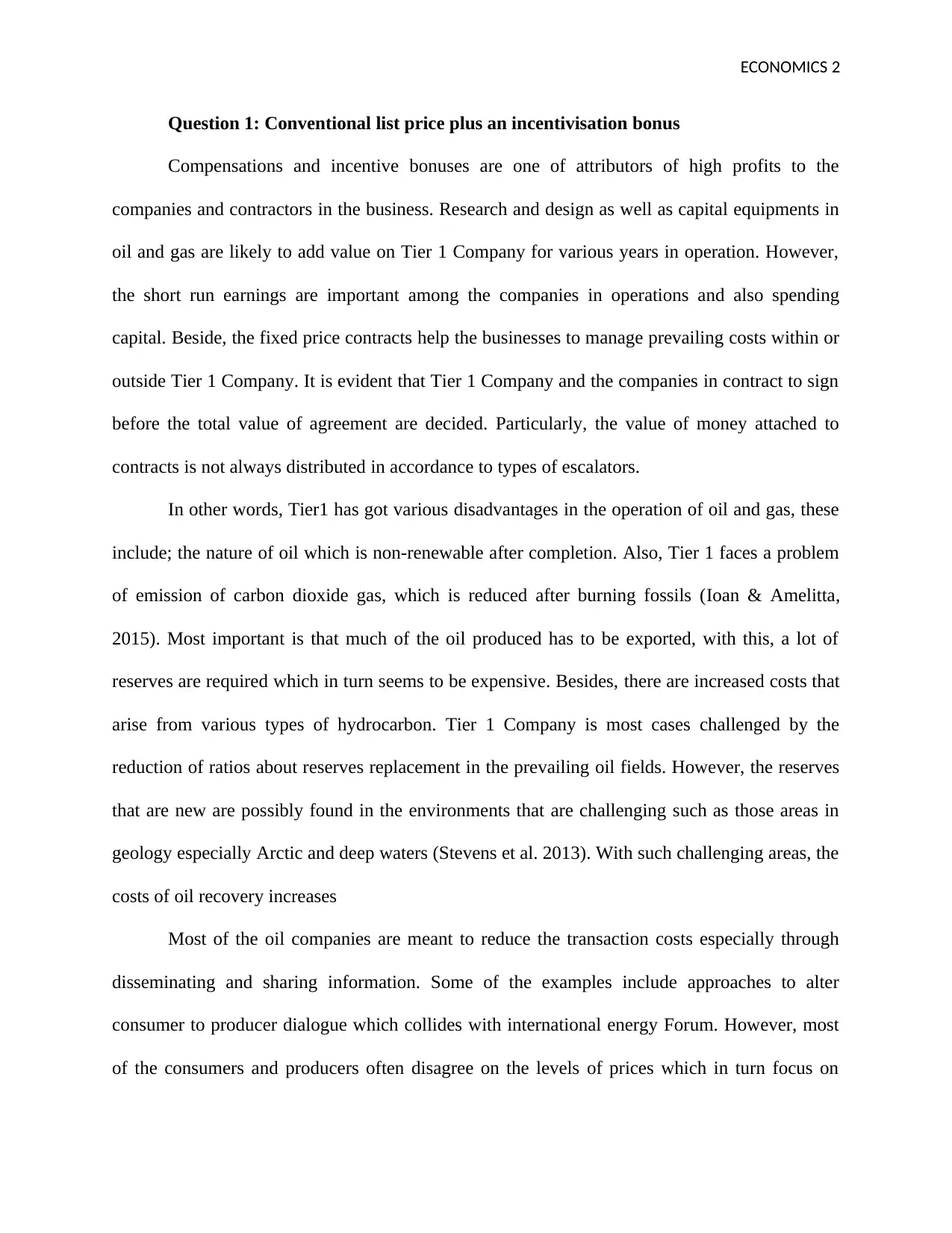
ECONOMICS 2
Question 1: Conventional list price plus an incentivisation bonus
Compensations and incentive bonuses are one of attributors of high profits to the
companies and contractors in the business. Research and design as well as capital equipments in
oil and gas are likely to add value on Tier 1 Company for various years in operation. However,
the short run earnings are important among the companies in operations and also spending
capital. Beside, the fixed price contracts help the businesses to manage prevailing costs within or
outside Tier 1 Company. It is evident that Tier 1 Company and the companies in contract to sign
before the total value of agreement are decided. Particularly, the value of money attached to
contracts is not always distributed in accordance to types of escalators.
In other words, Tier1 has got various disadvantages in the operation of oil and gas, these
include; the nature of oil which is non-renewable after completion. Also, Tier 1 faces a problem
of emission of carbon dioxide gas, which is reduced after burning fossils (Ioan & Amelitta,
2015). Most important is that much of the oil produced has to be exported, with this, a lot of
reserves are required which in turn seems to be expensive. Besides, there are increased costs that
arise from various types of hydrocarbon. Tier 1 Company is most cases challenged by the
reduction of ratios about reserves replacement in the prevailing oil fields. However, the reserves
that are new are possibly found in the environments that are challenging such as those areas in
geology especially Arctic and deep waters (Stevens et al. 2013). With such challenging areas, the
costs of oil recovery increases
Most of the oil companies are meant to reduce the transaction costs especially through
disseminating and sharing information. Some of the examples include approaches to alter
consumer to producer dialogue which collides with international energy Forum. However, most
of the consumers and producers often disagree on the levels of prices which in turn focus on
Question 1: Conventional list price plus an incentivisation bonus
Compensations and incentive bonuses are one of attributors of high profits to the
companies and contractors in the business. Research and design as well as capital equipments in
oil and gas are likely to add value on Tier 1 Company for various years in operation. However,
the short run earnings are important among the companies in operations and also spending
capital. Beside, the fixed price contracts help the businesses to manage prevailing costs within or
outside Tier 1 Company. It is evident that Tier 1 Company and the companies in contract to sign
before the total value of agreement are decided. Particularly, the value of money attached to
contracts is not always distributed in accordance to types of escalators.
In other words, Tier1 has got various disadvantages in the operation of oil and gas, these
include; the nature of oil which is non-renewable after completion. Also, Tier 1 faces a problem
of emission of carbon dioxide gas, which is reduced after burning fossils (Ioan & Amelitta,
2015). Most important is that much of the oil produced has to be exported, with this, a lot of
reserves are required which in turn seems to be expensive. Besides, there are increased costs that
arise from various types of hydrocarbon. Tier 1 Company is most cases challenged by the
reduction of ratios about reserves replacement in the prevailing oil fields. However, the reserves
that are new are possibly found in the environments that are challenging such as those areas in
geology especially Arctic and deep waters (Stevens et al. 2013). With such challenging areas, the
costs of oil recovery increases
Most of the oil companies are meant to reduce the transaction costs especially through
disseminating and sharing information. Some of the examples include approaches to alter
consumer to producer dialogue which collides with international energy Forum. However, most
of the consumers and producers often disagree on the levels of prices which in turn focus on
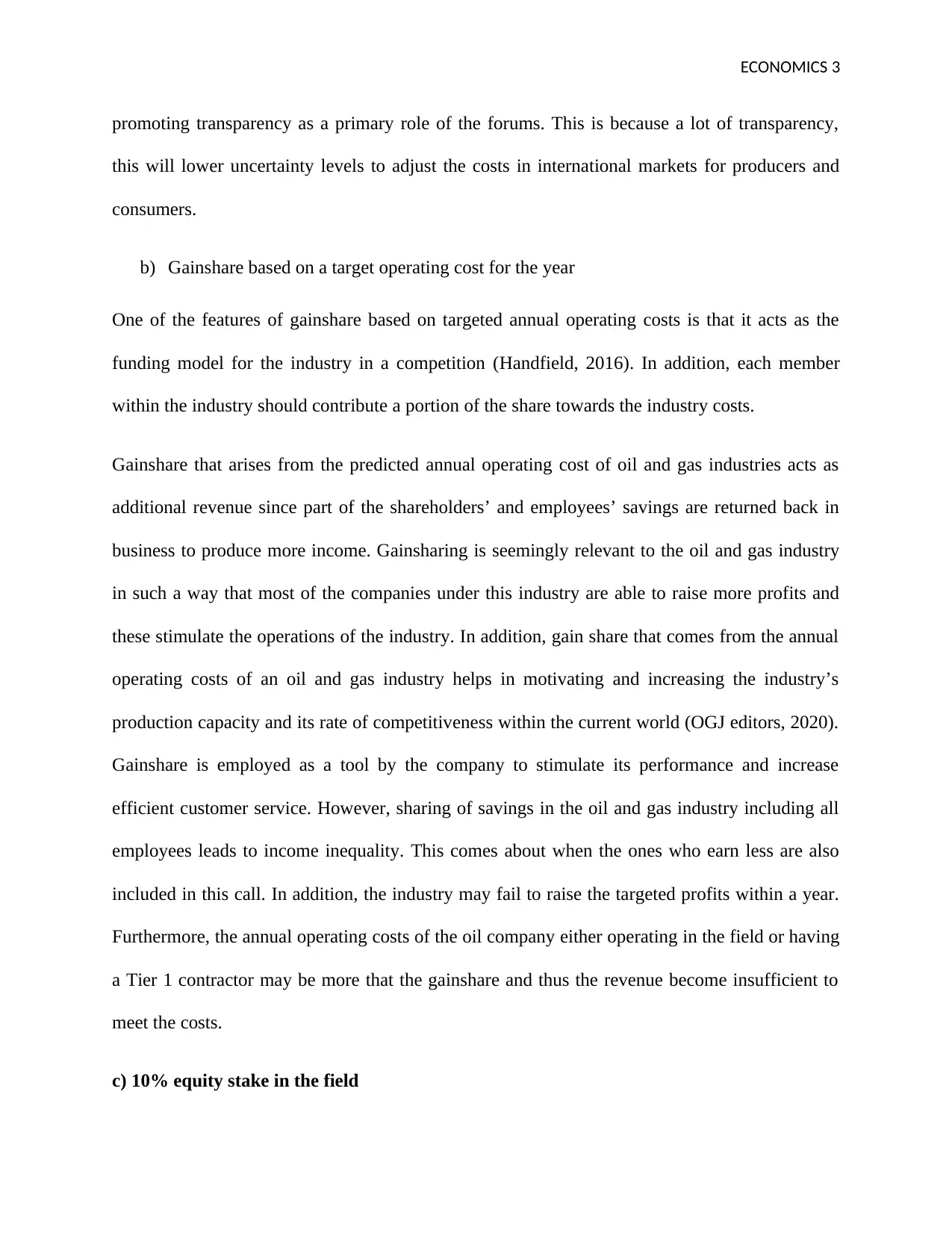
ECONOMICS 3
promoting transparency as a primary role of the forums. This is because a lot of transparency,
this will lower uncertainty levels to adjust the costs in international markets for producers and
consumers.
b) Gainshare based on a target operating cost for the year
One of the features of gainshare based on targeted annual operating costs is that it acts as the
funding model for the industry in a competition (Handfield, 2016). In addition, each member
within the industry should contribute a portion of the share towards the industry costs.
Gainshare that arises from the predicted annual operating cost of oil and gas industries acts as
additional revenue since part of the shareholders’ and employees’ savings are returned back in
business to produce more income. Gainsharing is seemingly relevant to the oil and gas industry
in such a way that most of the companies under this industry are able to raise more profits and
these stimulate the operations of the industry. In addition, gain share that comes from the annual
operating costs of an oil and gas industry helps in motivating and increasing the industry’s
production capacity and its rate of competitiveness within the current world (OGJ editors, 2020).
Gainshare is employed as a tool by the company to stimulate its performance and increase
efficient customer service. However, sharing of savings in the oil and gas industry including all
employees leads to income inequality. This comes about when the ones who earn less are also
included in this call. In addition, the industry may fail to raise the targeted profits within a year.
Furthermore, the annual operating costs of the oil company either operating in the field or having
a Tier 1 contractor may be more that the gainshare and thus the revenue become insufficient to
meet the costs.
c) 10% equity stake in the field
promoting transparency as a primary role of the forums. This is because a lot of transparency,
this will lower uncertainty levels to adjust the costs in international markets for producers and
consumers.
b) Gainshare based on a target operating cost for the year
One of the features of gainshare based on targeted annual operating costs is that it acts as the
funding model for the industry in a competition (Handfield, 2016). In addition, each member
within the industry should contribute a portion of the share towards the industry costs.
Gainshare that arises from the predicted annual operating cost of oil and gas industries acts as
additional revenue since part of the shareholders’ and employees’ savings are returned back in
business to produce more income. Gainsharing is seemingly relevant to the oil and gas industry
in such a way that most of the companies under this industry are able to raise more profits and
these stimulate the operations of the industry. In addition, gain share that comes from the annual
operating costs of an oil and gas industry helps in motivating and increasing the industry’s
production capacity and its rate of competitiveness within the current world (OGJ editors, 2020).
Gainshare is employed as a tool by the company to stimulate its performance and increase
efficient customer service. However, sharing of savings in the oil and gas industry including all
employees leads to income inequality. This comes about when the ones who earn less are also
included in this call. In addition, the industry may fail to raise the targeted profits within a year.
Furthermore, the annual operating costs of the oil company either operating in the field or having
a Tier 1 contractor may be more that the gainshare and thus the revenue become insufficient to
meet the costs.
c) 10% equity stake in the field
⊘ This is a preview!⊘
Do you want full access?
Subscribe today to unlock all pages.

Trusted by 1+ million students worldwide
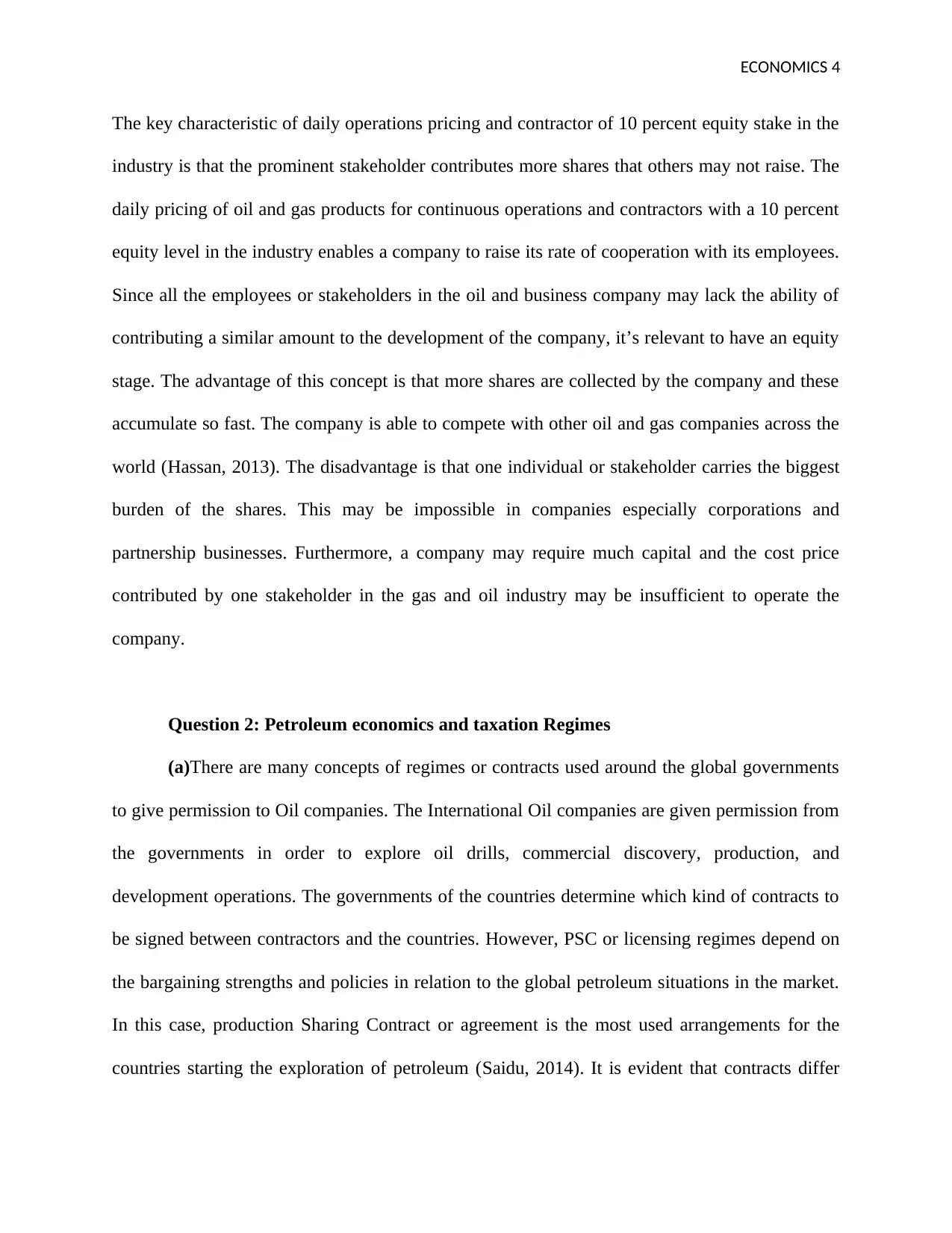
ECONOMICS 4
The key characteristic of daily operations pricing and contractor of 10 percent equity stake in the
industry is that the prominent stakeholder contributes more shares that others may not raise. The
daily pricing of oil and gas products for continuous operations and contractors with a 10 percent
equity level in the industry enables a company to raise its rate of cooperation with its employees.
Since all the employees or stakeholders in the oil and business company may lack the ability of
contributing a similar amount to the development of the company, it’s relevant to have an equity
stage. The advantage of this concept is that more shares are collected by the company and these
accumulate so fast. The company is able to compete with other oil and gas companies across the
world (Hassan, 2013). The disadvantage is that one individual or stakeholder carries the biggest
burden of the shares. This may be impossible in companies especially corporations and
partnership businesses. Furthermore, a company may require much capital and the cost price
contributed by one stakeholder in the gas and oil industry may be insufficient to operate the
company.
Question 2: Petroleum economics and taxation Regimes
(a)There are many concepts of regimes or contracts used around the global governments
to give permission to Oil companies. The International Oil companies are given permission from
the governments in order to explore oil drills, commercial discovery, production, and
development operations. The governments of the countries determine which kind of contracts to
be signed between contractors and the countries. However, PSC or licensing regimes depend on
the bargaining strengths and policies in relation to the global petroleum situations in the market.
In this case, production Sharing Contract or agreement is the most used arrangements for the
countries starting the exploration of petroleum (Saidu, 2014). It is evident that contracts differ
The key characteristic of daily operations pricing and contractor of 10 percent equity stake in the
industry is that the prominent stakeholder contributes more shares that others may not raise. The
daily pricing of oil and gas products for continuous operations and contractors with a 10 percent
equity level in the industry enables a company to raise its rate of cooperation with its employees.
Since all the employees or stakeholders in the oil and business company may lack the ability of
contributing a similar amount to the development of the company, it’s relevant to have an equity
stage. The advantage of this concept is that more shares are collected by the company and these
accumulate so fast. The company is able to compete with other oil and gas companies across the
world (Hassan, 2013). The disadvantage is that one individual or stakeholder carries the biggest
burden of the shares. This may be impossible in companies especially corporations and
partnership businesses. Furthermore, a company may require much capital and the cost price
contributed by one stakeholder in the gas and oil industry may be insufficient to operate the
company.
Question 2: Petroleum economics and taxation Regimes
(a)There are many concepts of regimes or contracts used around the global governments
to give permission to Oil companies. The International Oil companies are given permission from
the governments in order to explore oil drills, commercial discovery, production, and
development operations. The governments of the countries determine which kind of contracts to
be signed between contractors and the countries. However, PSC or licensing regimes depend on
the bargaining strengths and policies in relation to the global petroleum situations in the market.
In this case, production Sharing Contract or agreement is the most used arrangements for the
countries starting the exploration of petroleum (Saidu, 2014). It is evident that contracts differ
Paraphrase This Document
Need a fresh take? Get an instant paraphrase of this document with our AI Paraphraser

ECONOMICS 5
from the conceptual status especially those regarding with the foreign contractors, and
compensations involved by the National oil companies.
Production Sharing Contracts (PSC) is used by the governments due to their adaptability
and flexibility nature. With this PSC, it becomes easy to spill the production of final petroleum
for the country in relation to the local conditions. Besides, the traditional license agreements are
not adaptable and flexible as compared to production sharing contracts. More so, PSC features
that separate it from other systems of licensing is about contractual relations that emanate from
the two legal parties (Adomako-Kwakye, 2017). Moreover, this can be attained after the parties
fulfill the obligations as well as the violation penalties in order to entail the legal liability.
In addition, other contracts offer the agreements that allow national oil companies to
involve directly in the process of development, where the oil fields are operated by the
International oil companies. For instance, Pertamina in Indonesia may wish to take almost 15%
commercial discovery interests which are not the case with other governments (Seljom &
Rosenberg, 2011). Therefore, the scheme of participation is related to the venture of concession
joint. However, National Oil Companies participation is involved in unappealing by the
International Oil Companies, which can interrupt with the daily effective operations of the
project.
In particular, Production sharing contract helps in guarantying tax stability as well as
giving potential investors to assess and find out the taxes that would benefit them. This is
because the PSC replaces the obligatory and tax charges which in turn lead to profit generation.
With this, the investors or international oil companies enjoy the special treatment of taxes that is
offered by the production sharing contract (Oyewunmi 2011). Furthermore, it is the system of the
from the conceptual status especially those regarding with the foreign contractors, and
compensations involved by the National oil companies.
Production Sharing Contracts (PSC) is used by the governments due to their adaptability
and flexibility nature. With this PSC, it becomes easy to spill the production of final petroleum
for the country in relation to the local conditions. Besides, the traditional license agreements are
not adaptable and flexible as compared to production sharing contracts. More so, PSC features
that separate it from other systems of licensing is about contractual relations that emanate from
the two legal parties (Adomako-Kwakye, 2017). Moreover, this can be attained after the parties
fulfill the obligations as well as the violation penalties in order to entail the legal liability.
In addition, other contracts offer the agreements that allow national oil companies to
involve directly in the process of development, where the oil fields are operated by the
International oil companies. For instance, Pertamina in Indonesia may wish to take almost 15%
commercial discovery interests which are not the case with other governments (Seljom &
Rosenberg, 2011). Therefore, the scheme of participation is related to the venture of concession
joint. However, National Oil Companies participation is involved in unappealing by the
International Oil Companies, which can interrupt with the daily effective operations of the
project.
In particular, Production sharing contract helps in guarantying tax stability as well as
giving potential investors to assess and find out the taxes that would benefit them. This is
because the PSC replaces the obligatory and tax charges which in turn lead to profit generation.
With this, the investors or international oil companies enjoy the special treatment of taxes that is
offered by the production sharing contract (Oyewunmi 2011). Furthermore, it is the system of the
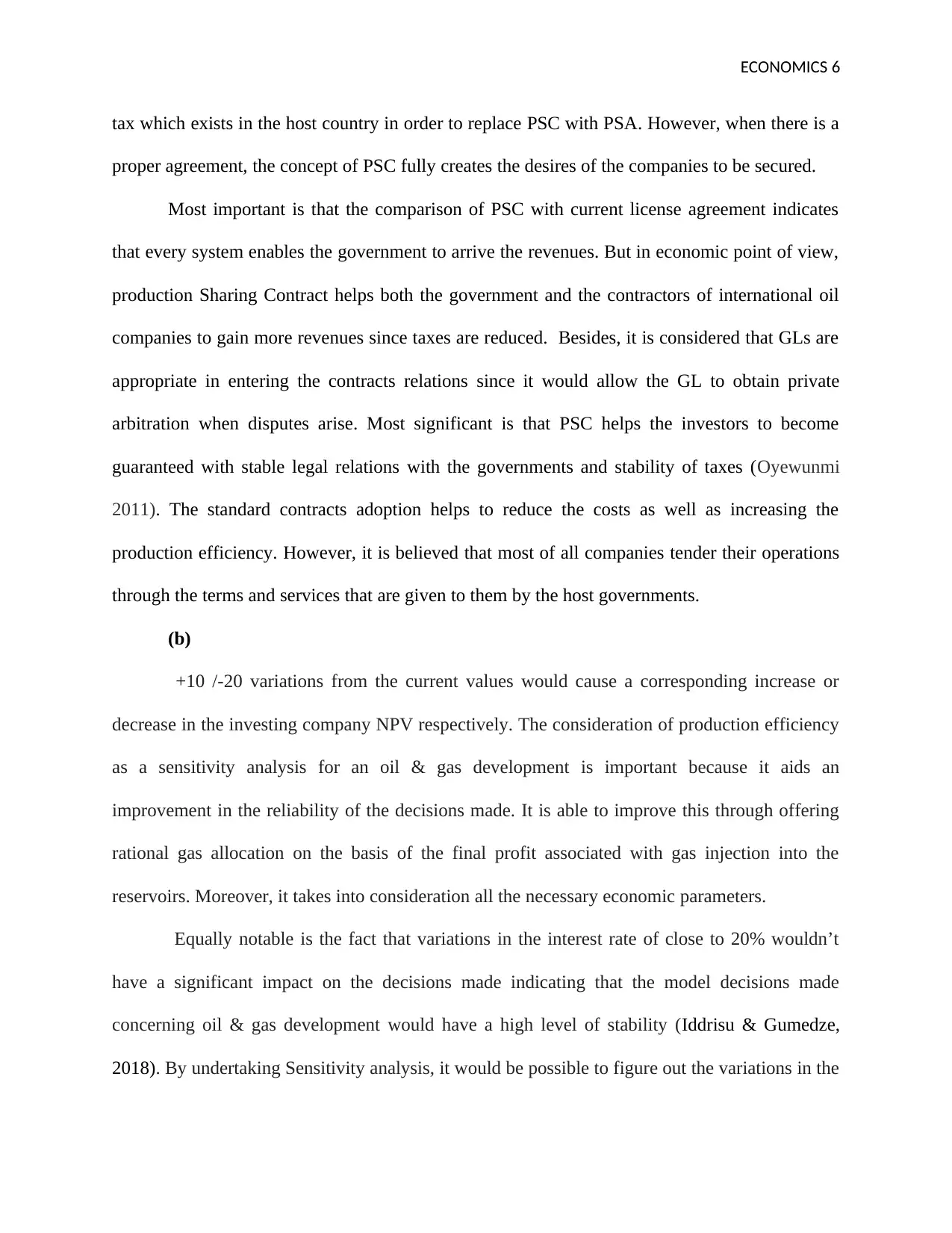
ECONOMICS 6
tax which exists in the host country in order to replace PSC with PSA. However, when there is a
proper agreement, the concept of PSC fully creates the desires of the companies to be secured.
Most important is that the comparison of PSC with current license agreement indicates
that every system enables the government to arrive the revenues. But in economic point of view,
production Sharing Contract helps both the government and the contractors of international oil
companies to gain more revenues since taxes are reduced. Besides, it is considered that GLs are
appropriate in entering the contracts relations since it would allow the GL to obtain private
arbitration when disputes arise. Most significant is that PSC helps the investors to become
guaranteed with stable legal relations with the governments and stability of taxes (Oyewunmi
2011). The standard contracts adoption helps to reduce the costs as well as increasing the
production efficiency. However, it is believed that most of all companies tender their operations
through the terms and services that are given to them by the host governments.
(b)
+10 /-20 variations from the current values would cause a corresponding increase or
decrease in the investing company NPV respectively. The consideration of production efficiency
as a sensitivity analysis for an oil & gas development is important because it aids an
improvement in the reliability of the decisions made. It is able to improve this through offering
rational gas allocation on the basis of the final profit associated with gas injection into the
reservoirs. Moreover, it takes into consideration all the necessary economic parameters.
Equally notable is the fact that variations in the interest rate of close to 20% wouldn’t
have a significant impact on the decisions made indicating that the model decisions made
concerning oil & gas development would have a high level of stability (Iddrisu & Gumedze,
2018). By undertaking Sensitivity analysis, it would be possible to figure out the variations in the
tax which exists in the host country in order to replace PSC with PSA. However, when there is a
proper agreement, the concept of PSC fully creates the desires of the companies to be secured.
Most important is that the comparison of PSC with current license agreement indicates
that every system enables the government to arrive the revenues. But in economic point of view,
production Sharing Contract helps both the government and the contractors of international oil
companies to gain more revenues since taxes are reduced. Besides, it is considered that GLs are
appropriate in entering the contracts relations since it would allow the GL to obtain private
arbitration when disputes arise. Most significant is that PSC helps the investors to become
guaranteed with stable legal relations with the governments and stability of taxes (Oyewunmi
2011). The standard contracts adoption helps to reduce the costs as well as increasing the
production efficiency. However, it is believed that most of all companies tender their operations
through the terms and services that are given to them by the host governments.
(b)
+10 /-20 variations from the current values would cause a corresponding increase or
decrease in the investing company NPV respectively. The consideration of production efficiency
as a sensitivity analysis for an oil & gas development is important because it aids an
improvement in the reliability of the decisions made. It is able to improve this through offering
rational gas allocation on the basis of the final profit associated with gas injection into the
reservoirs. Moreover, it takes into consideration all the necessary economic parameters.
Equally notable is the fact that variations in the interest rate of close to 20% wouldn’t
have a significant impact on the decisions made indicating that the model decisions made
concerning oil & gas development would have a high level of stability (Iddrisu & Gumedze,
2018). By undertaking Sensitivity analysis, it would be possible to figure out the variations in the
⊘ This is a preview!⊘
Do you want full access?
Subscribe today to unlock all pages.

Trusted by 1+ million students worldwide
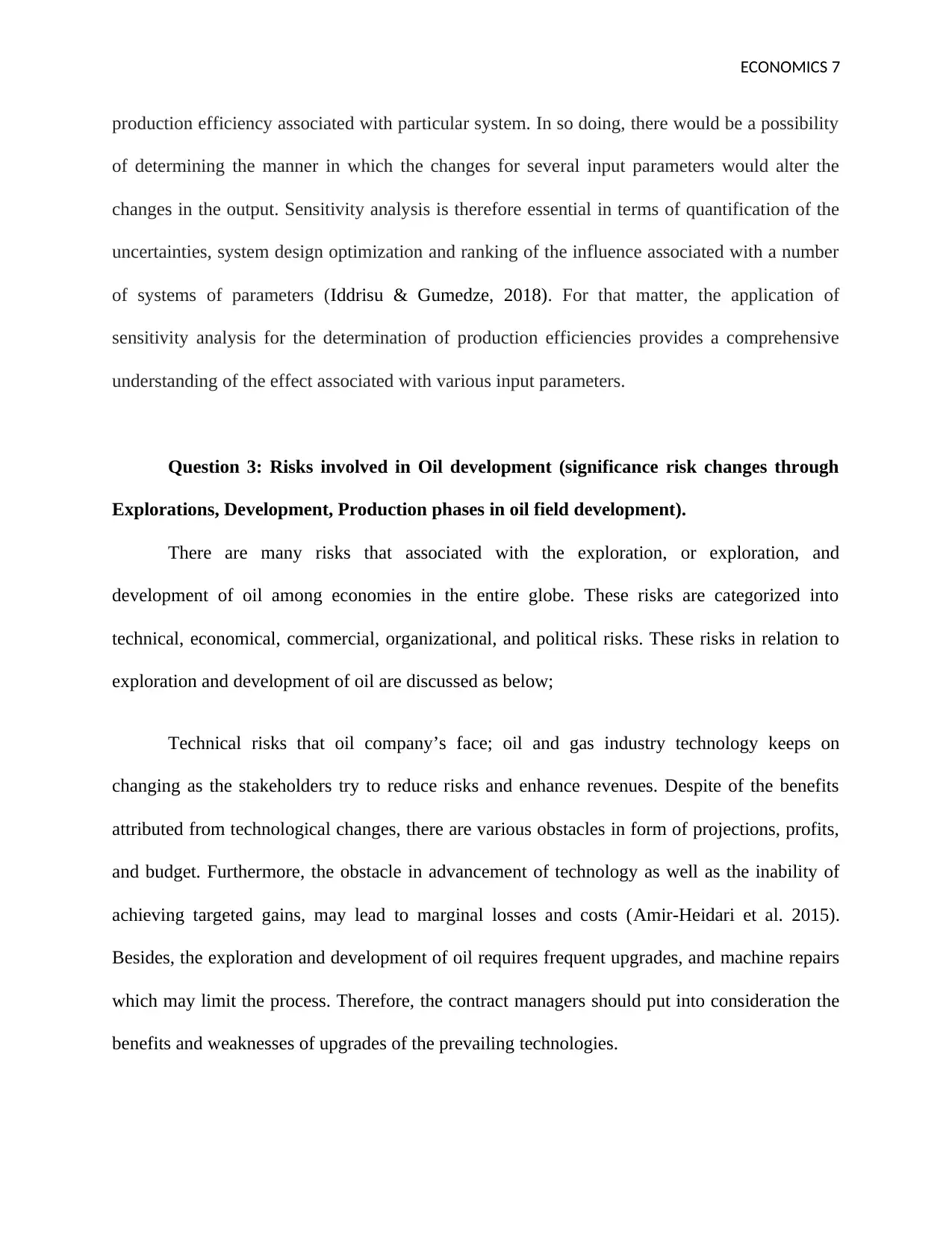
ECONOMICS 7
production efficiency associated with particular system. In so doing, there would be a possibility
of determining the manner in which the changes for several input parameters would alter the
changes in the output. Sensitivity analysis is therefore essential in terms of quantification of the
uncertainties, system design optimization and ranking of the influence associated with a number
of systems of parameters (Iddrisu & Gumedze, 2018). For that matter, the application of
sensitivity analysis for the determination of production efficiencies provides a comprehensive
understanding of the effect associated with various input parameters.
Question 3: Risks involved in Oil development (significance risk changes through
Explorations, Development, Production phases in oil field development).
There are many risks that associated with the exploration, or exploration, and
development of oil among economies in the entire globe. These risks are categorized into
technical, economical, commercial, organizational, and political risks. These risks in relation to
exploration and development of oil are discussed as below;
Technical risks that oil company’s face; oil and gas industry technology keeps on
changing as the stakeholders try to reduce risks and enhance revenues. Despite of the benefits
attributed from technological changes, there are various obstacles in form of projections, profits,
and budget. Furthermore, the obstacle in advancement of technology as well as the inability of
achieving targeted gains, may lead to marginal losses and costs (Amir-Heidari et al. 2015).
Besides, the exploration and development of oil requires frequent upgrades, and machine repairs
which may limit the process. Therefore, the contract managers should put into consideration the
benefits and weaknesses of upgrades of the prevailing technologies.
production efficiency associated with particular system. In so doing, there would be a possibility
of determining the manner in which the changes for several input parameters would alter the
changes in the output. Sensitivity analysis is therefore essential in terms of quantification of the
uncertainties, system design optimization and ranking of the influence associated with a number
of systems of parameters (Iddrisu & Gumedze, 2018). For that matter, the application of
sensitivity analysis for the determination of production efficiencies provides a comprehensive
understanding of the effect associated with various input parameters.
Question 3: Risks involved in Oil development (significance risk changes through
Explorations, Development, Production phases in oil field development).
There are many risks that associated with the exploration, or exploration, and
development of oil among economies in the entire globe. These risks are categorized into
technical, economical, commercial, organizational, and political risks. These risks in relation to
exploration and development of oil are discussed as below;
Technical risks that oil company’s face; oil and gas industry technology keeps on
changing as the stakeholders try to reduce risks and enhance revenues. Despite of the benefits
attributed from technological changes, there are various obstacles in form of projections, profits,
and budget. Furthermore, the obstacle in advancement of technology as well as the inability of
achieving targeted gains, may lead to marginal losses and costs (Amir-Heidari et al. 2015).
Besides, the exploration and development of oil requires frequent upgrades, and machine repairs
which may limit the process. Therefore, the contract managers should put into consideration the
benefits and weaknesses of upgrades of the prevailing technologies.
Paraphrase This Document
Need a fresh take? Get an instant paraphrase of this document with our AI Paraphraser
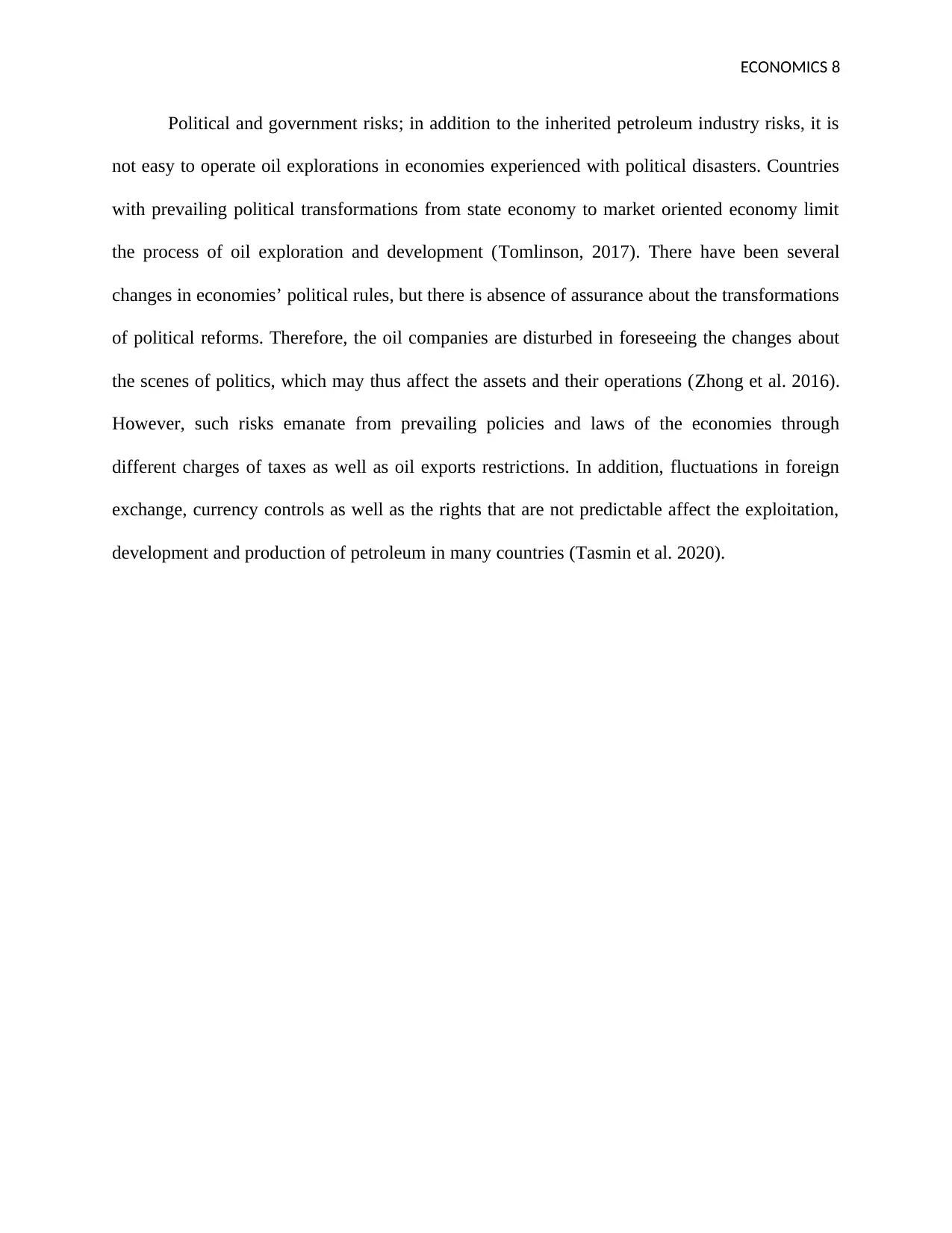
ECONOMICS 8
Political and government risks; in addition to the inherited petroleum industry risks, it is
not easy to operate oil explorations in economies experienced with political disasters. Countries
with prevailing political transformations from state economy to market oriented economy limit
the process of oil exploration and development (Tomlinson, 2017). There have been several
changes in economies’ political rules, but there is absence of assurance about the transformations
of political reforms. Therefore, the oil companies are disturbed in foreseeing the changes about
the scenes of politics, which may thus affect the assets and their operations (Zhong et al. 2016).
However, such risks emanate from prevailing policies and laws of the economies through
different charges of taxes as well as oil exports restrictions. In addition, fluctuations in foreign
exchange, currency controls as well as the rights that are not predictable affect the exploitation,
development and production of petroleum in many countries (Tasmin et al. 2020).
Political and government risks; in addition to the inherited petroleum industry risks, it is
not easy to operate oil explorations in economies experienced with political disasters. Countries
with prevailing political transformations from state economy to market oriented economy limit
the process of oil exploration and development (Tomlinson, 2017). There have been several
changes in economies’ political rules, but there is absence of assurance about the transformations
of political reforms. Therefore, the oil companies are disturbed in foreseeing the changes about
the scenes of politics, which may thus affect the assets and their operations (Zhong et al. 2016).
However, such risks emanate from prevailing policies and laws of the economies through
different charges of taxes as well as oil exports restrictions. In addition, fluctuations in foreign
exchange, currency controls as well as the rights that are not predictable affect the exploitation,
development and production of petroleum in many countries (Tasmin et al. 2020).
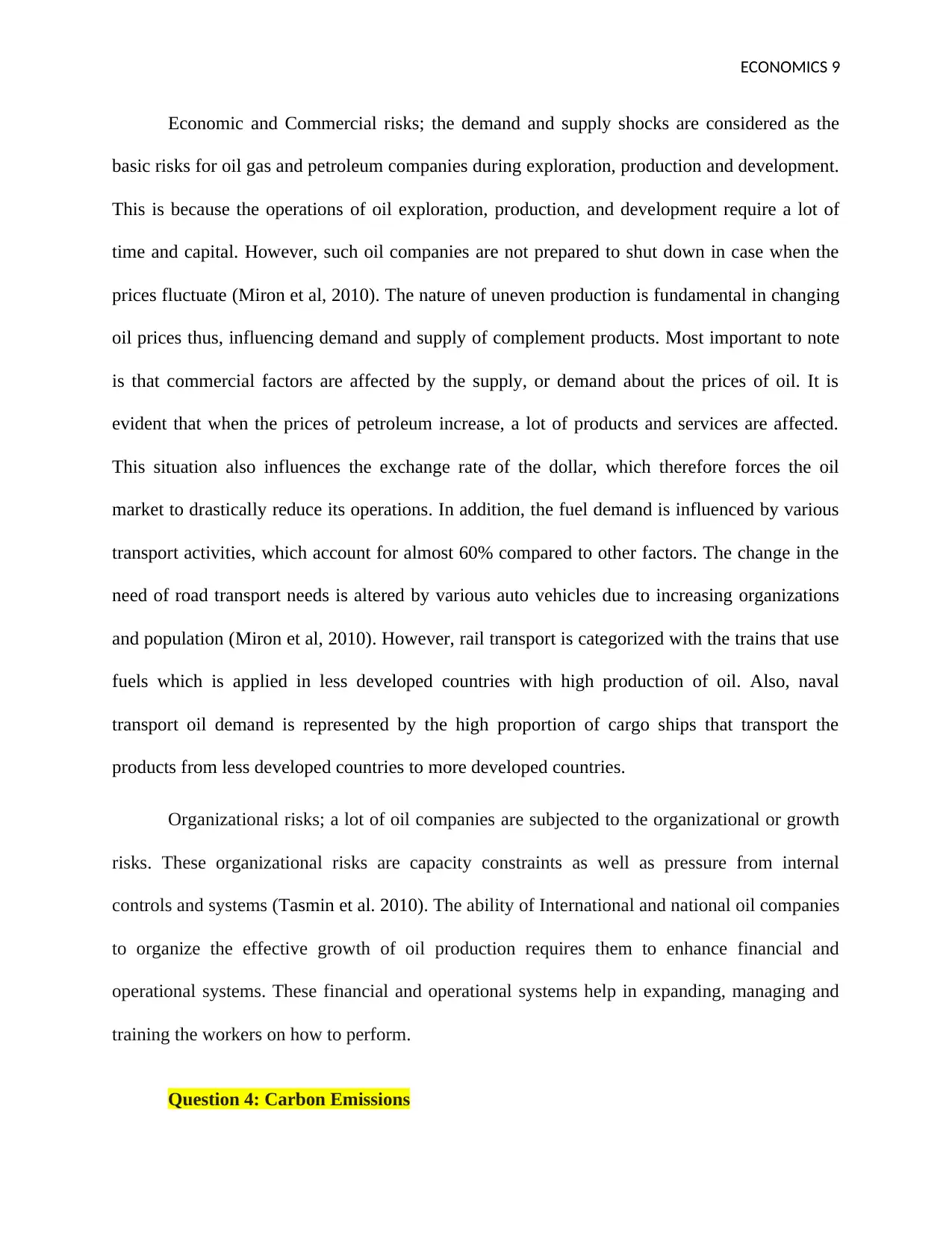
ECONOMICS 9
Economic and Commercial risks; the demand and supply shocks are considered as the
basic risks for oil gas and petroleum companies during exploration, production and development.
This is because the operations of oil exploration, production, and development require a lot of
time and capital. However, such oil companies are not prepared to shut down in case when the
prices fluctuate (Miron et al, 2010). The nature of uneven production is fundamental in changing
oil prices thus, influencing demand and supply of complement products. Most important to note
is that commercial factors are affected by the supply, or demand about the prices of oil. It is
evident that when the prices of petroleum increase, a lot of products and services are affected.
This situation also influences the exchange rate of the dollar, which therefore forces the oil
market to drastically reduce its operations. In addition, the fuel demand is influenced by various
transport activities, which account for almost 60% compared to other factors. The change in the
need of road transport needs is altered by various auto vehicles due to increasing organizations
and population (Miron et al, 2010). However, rail transport is categorized with the trains that use
fuels which is applied in less developed countries with high production of oil. Also, naval
transport oil demand is represented by the high proportion of cargo ships that transport the
products from less developed countries to more developed countries.
Organizational risks; a lot of oil companies are subjected to the organizational or growth
risks. These organizational risks are capacity constraints as well as pressure from internal
controls and systems (Tasmin et al. 2010). The ability of International and national oil companies
to organize the effective growth of oil production requires them to enhance financial and
operational systems. These financial and operational systems help in expanding, managing and
training the workers on how to perform.
Question 4: Carbon Emissions
Economic and Commercial risks; the demand and supply shocks are considered as the
basic risks for oil gas and petroleum companies during exploration, production and development.
This is because the operations of oil exploration, production, and development require a lot of
time and capital. However, such oil companies are not prepared to shut down in case when the
prices fluctuate (Miron et al, 2010). The nature of uneven production is fundamental in changing
oil prices thus, influencing demand and supply of complement products. Most important to note
is that commercial factors are affected by the supply, or demand about the prices of oil. It is
evident that when the prices of petroleum increase, a lot of products and services are affected.
This situation also influences the exchange rate of the dollar, which therefore forces the oil
market to drastically reduce its operations. In addition, the fuel demand is influenced by various
transport activities, which account for almost 60% compared to other factors. The change in the
need of road transport needs is altered by various auto vehicles due to increasing organizations
and population (Miron et al, 2010). However, rail transport is categorized with the trains that use
fuels which is applied in less developed countries with high production of oil. Also, naval
transport oil demand is represented by the high proportion of cargo ships that transport the
products from less developed countries to more developed countries.
Organizational risks; a lot of oil companies are subjected to the organizational or growth
risks. These organizational risks are capacity constraints as well as pressure from internal
controls and systems (Tasmin et al. 2010). The ability of International and national oil companies
to organize the effective growth of oil production requires them to enhance financial and
operational systems. These financial and operational systems help in expanding, managing and
training the workers on how to perform.
Question 4: Carbon Emissions
⊘ This is a preview!⊘
Do you want full access?
Subscribe today to unlock all pages.

Trusted by 1+ million students worldwide

ECONOMICS 10
Mankind has been considered as one of the major contributors of carbon emissions in a
single year. According to Global Carbon Project, over 2,000 billion tons in metrics of carbon
emissions are added to atmosphere by mankind (Suner, 2019). The factors may include;
Landscape changes especially deforestation have been fundamental towards carbon
emissions according to the Global Carbon project. It is evident that over 40 billion metric tons of
carbon dioxide in 2015 was estimated to have been caused by deforestation (Eskeland &
Harrison, 2013). This is because trees absorb greenhouse gases especially carbon dioxide, which
prevents them to accumulate the atmosphere (Suner, 2019). This situation therefore leads to
global warming since most forests and bush are cleared for different mankind activities.
In addition, agriculture is also fundamental in causing annual carbon emissions. This is
done because of modernization of agriculture, which requires production, storage, packaging,
preparation, and transportation. It is evident that every stage of production of food at least causes
a substantial greenhouse gas amounts (Beattie, 2019). Moreover, agriculture is considered as one
of the major causes of climatic changes though gas emissions.
Furthermore, industrialization is also one of the greatest contributors of annual carbon
emissions. Although the revolution of industries has increased the standards of living in different
cases, it’s also attached with adverse effects to the environment (Loris, 2009). Since most of
labor has been replaced by machineries, a lot of fumes are emitted. Industrialization and
commercialization increment have increased the usage of fossil fuels, thus leading to climate
change and global warming.
Future carbon dioxide
Mankind has been considered as one of the major contributors of carbon emissions in a
single year. According to Global Carbon Project, over 2,000 billion tons in metrics of carbon
emissions are added to atmosphere by mankind (Suner, 2019). The factors may include;
Landscape changes especially deforestation have been fundamental towards carbon
emissions according to the Global Carbon project. It is evident that over 40 billion metric tons of
carbon dioxide in 2015 was estimated to have been caused by deforestation (Eskeland &
Harrison, 2013). This is because trees absorb greenhouse gases especially carbon dioxide, which
prevents them to accumulate the atmosphere (Suner, 2019). This situation therefore leads to
global warming since most forests and bush are cleared for different mankind activities.
In addition, agriculture is also fundamental in causing annual carbon emissions. This is
done because of modernization of agriculture, which requires production, storage, packaging,
preparation, and transportation. It is evident that every stage of production of food at least causes
a substantial greenhouse gas amounts (Beattie, 2019). Moreover, agriculture is considered as one
of the major causes of climatic changes though gas emissions.
Furthermore, industrialization is also one of the greatest contributors of annual carbon
emissions. Although the revolution of industries has increased the standards of living in different
cases, it’s also attached with adverse effects to the environment (Loris, 2009). Since most of
labor has been replaced by machineries, a lot of fumes are emitted. Industrialization and
commercialization increment have increased the usage of fossil fuels, thus leading to climate
change and global warming.
Future carbon dioxide
Paraphrase This Document
Need a fresh take? Get an instant paraphrase of this document with our AI Paraphraser
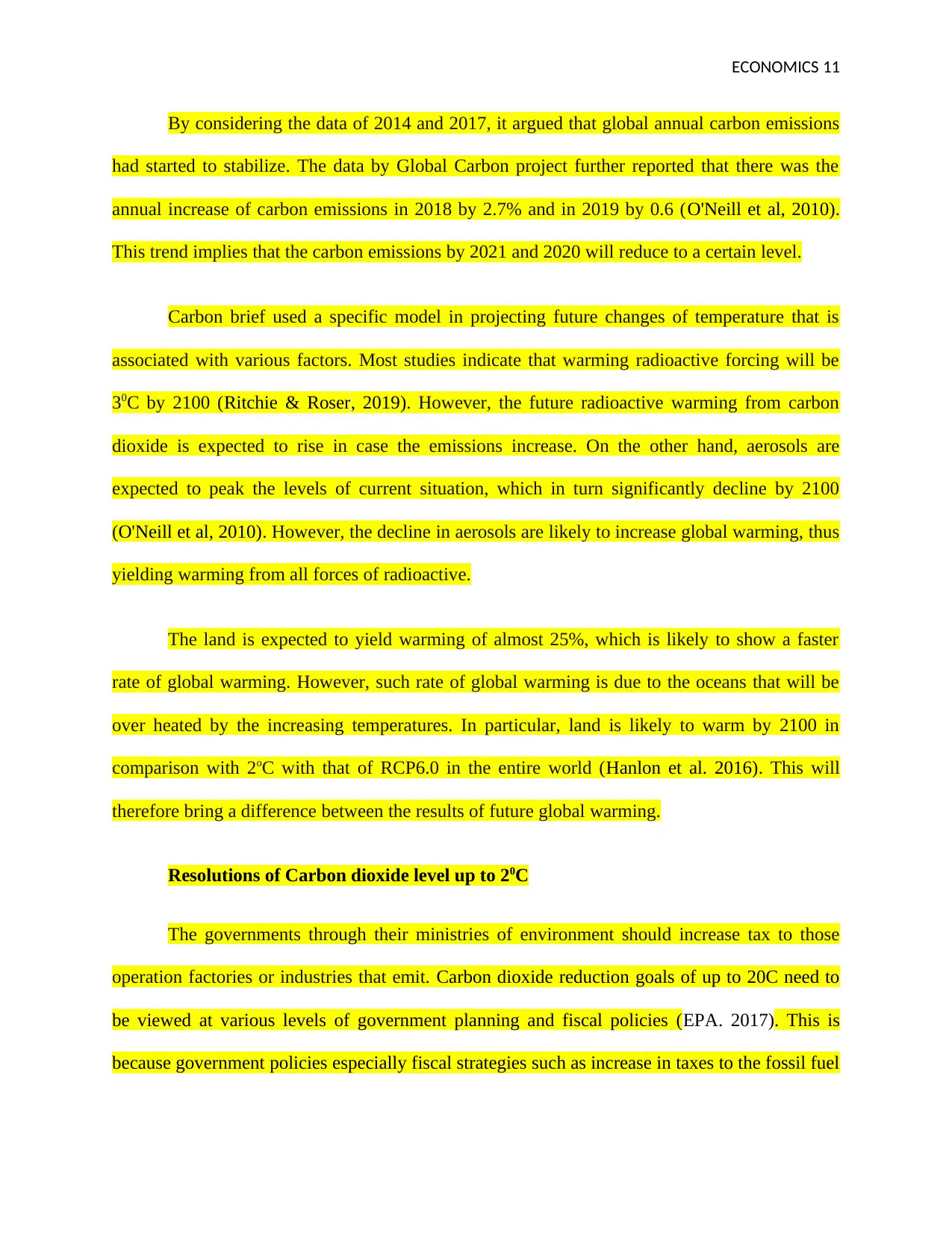
ECONOMICS 11
By considering the data of 2014 and 2017, it argued that global annual carbon emissions
had started to stabilize. The data by Global Carbon project further reported that there was the
annual increase of carbon emissions in 2018 by 2.7% and in 2019 by 0.6 (O'Neill et al, 2010).
This trend implies that the carbon emissions by 2021 and 2020 will reduce to a certain level.
Carbon brief used a specific model in projecting future changes of temperature that is
associated with various factors. Most studies indicate that warming radioactive forcing will be
30C by 2100 (Ritchie & Roser, 2019). However, the future radioactive warming from carbon
dioxide is expected to rise in case the emissions increase. On the other hand, aerosols are
expected to peak the levels of current situation, which in turn significantly decline by 2100
(O'Neill et al, 2010). However, the decline in aerosols are likely to increase global warming, thus
yielding warming from all forces of radioactive.
The land is expected to yield warming of almost 25%, which is likely to show a faster
rate of global warming. However, such rate of global warming is due to the oceans that will be
over heated by the increasing temperatures. In particular, land is likely to warm by 2100 in
comparison with 2oC with that of RCP6.0 in the entire world (Hanlon et al. 2016). This will
therefore bring a difference between the results of future global warming.
Resolutions of Carbon dioxide level up to 20C
The governments through their ministries of environment should increase tax to those
operation factories or industries that emit. Carbon dioxide reduction goals of up to 20C need to
be viewed at various levels of government planning and fiscal policies (EPA. 2017). This is
because government policies especially fiscal strategies such as increase in taxes to the fossil fuel
By considering the data of 2014 and 2017, it argued that global annual carbon emissions
had started to stabilize. The data by Global Carbon project further reported that there was the
annual increase of carbon emissions in 2018 by 2.7% and in 2019 by 0.6 (O'Neill et al, 2010).
This trend implies that the carbon emissions by 2021 and 2020 will reduce to a certain level.
Carbon brief used a specific model in projecting future changes of temperature that is
associated with various factors. Most studies indicate that warming radioactive forcing will be
30C by 2100 (Ritchie & Roser, 2019). However, the future radioactive warming from carbon
dioxide is expected to rise in case the emissions increase. On the other hand, aerosols are
expected to peak the levels of current situation, which in turn significantly decline by 2100
(O'Neill et al, 2010). However, the decline in aerosols are likely to increase global warming, thus
yielding warming from all forces of radioactive.
The land is expected to yield warming of almost 25%, which is likely to show a faster
rate of global warming. However, such rate of global warming is due to the oceans that will be
over heated by the increasing temperatures. In particular, land is likely to warm by 2100 in
comparison with 2oC with that of RCP6.0 in the entire world (Hanlon et al. 2016). This will
therefore bring a difference between the results of future global warming.
Resolutions of Carbon dioxide level up to 20C
The governments through their ministries of environment should increase tax to those
operation factories or industries that emit. Carbon dioxide reduction goals of up to 20C need to
be viewed at various levels of government planning and fiscal policies (EPA. 2017). This is
because government policies especially fiscal strategies such as increase in taxes to the fossil fuel

ECONOMICS 12
companies (WSJ, 2019). This will help to increase production costs thus, reducing the levels of
carbon dioxide gas around the globe.
Question 5: Planning and Execution of oil and gas field decommissioning
There are different steps considered by the oil and gas operator’s whereby a UK regulator
decommissions ceases the company when such steps are not made. These steps that may lead a
company that have run for at least five years to be decommissioned are;
Disposal costs step; in this case, the costs that relate the disposal and shutdown of some facilities
are very few related to those of exploration (Bozkurt & Akan, 2014). Therefore,
decommissioning becomes easier when the oil company possess high costs of disposal (Elsevier
B.V. 2013). However, the largest element or step in decommissioning the projects that are
similar to plugging of wells in permanent manner, leads to total removal of the well.
In addition, abandonment costs are considered as a step to decommission the oil
production company especially in United Kingdom. These costs can be traditionally applicable
especially in abandoning process in production of oil and gas (Schneider et al. 2013). Therefore,
when the wells are plugged with cement, as well as removal of equipments indicates a company
decommissioning of shutdown (Tarr, 2014). Therefore, the oil and gas company has to first
estimate the time and the costs both financial and environmental costs. This ought to help the
government regulators to run very well the process of oil without leading to negative impacts in
the Nation (Ahiaga-Dagbui et al. 2020). Most important is that well production by the company
is gauged by the government officials to determine where it is non-productive or productive after
drilling process.
companies (WSJ, 2019). This will help to increase production costs thus, reducing the levels of
carbon dioxide gas around the globe.
Question 5: Planning and Execution of oil and gas field decommissioning
There are different steps considered by the oil and gas operator’s whereby a UK regulator
decommissions ceases the company when such steps are not made. These steps that may lead a
company that have run for at least five years to be decommissioned are;
Disposal costs step; in this case, the costs that relate the disposal and shutdown of some facilities
are very few related to those of exploration (Bozkurt & Akan, 2014). Therefore,
decommissioning becomes easier when the oil company possess high costs of disposal (Elsevier
B.V. 2013). However, the largest element or step in decommissioning the projects that are
similar to plugging of wells in permanent manner, leads to total removal of the well.
In addition, abandonment costs are considered as a step to decommission the oil
production company especially in United Kingdom. These costs can be traditionally applicable
especially in abandoning process in production of oil and gas (Schneider et al. 2013). Therefore,
when the wells are plugged with cement, as well as removal of equipments indicates a company
decommissioning of shutdown (Tarr, 2014). Therefore, the oil and gas company has to first
estimate the time and the costs both financial and environmental costs. This ought to help the
government regulators to run very well the process of oil without leading to negative impacts in
the Nation (Ahiaga-Dagbui et al. 2020). Most important is that well production by the company
is gauged by the government officials to determine where it is non-productive or productive after
drilling process.
⊘ This is a preview!⊘
Do you want full access?
Subscribe today to unlock all pages.

Trusted by 1+ million students worldwide
1 out of 18
Related Documents
Your All-in-One AI-Powered Toolkit for Academic Success.
+13062052269
info@desklib.com
Available 24*7 on WhatsApp / Email
![[object Object]](/_next/static/media/star-bottom.7253800d.svg)
Unlock your academic potential
Copyright © 2020–2025 A2Z Services. All Rights Reserved. Developed and managed by ZUCOL.





